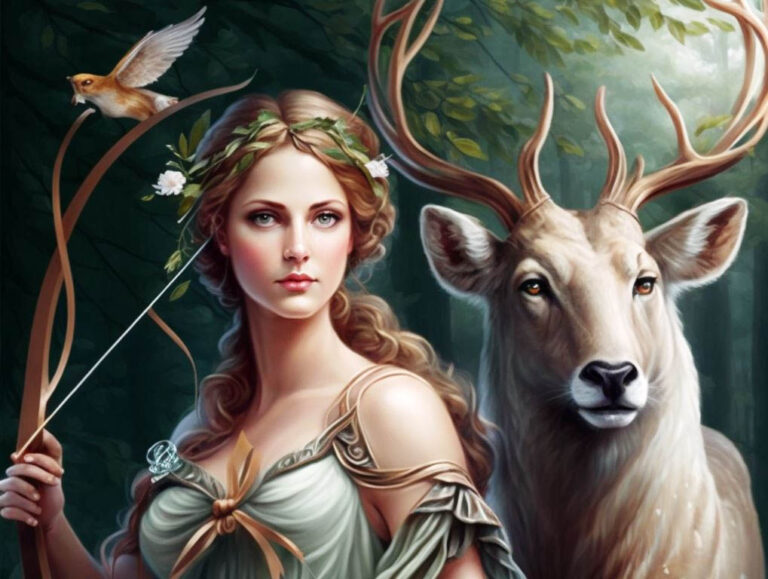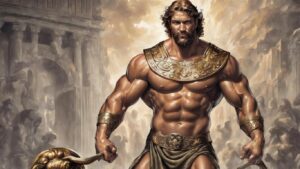Table of Contents
Who Is Artemis?
Purpose
Artemis, in Greek mythology, served various purposes, reflecting her diverse attributes and roles. Some key aspects of her purpose:
Goddess of the Hunt: Artemis is primarily known as the goddess of the hunt. She is often depicted with a bow and arrows, emphasizing her skill as an archer. Hunters and those seeking success in hunting would invoke her for assistance.
Protector of Wildlife and Wilderness: As the goddess of wilderness, Artemis was associated with the protection of wild animals and the natural world. She cared for and safeguarded the untamed aspects of nature.
Goddess of the Moon: Artemis was also linked to the moon, serving as the goddess of the moon in Greek mythology. This lunar aspect contributed to her role as a nocturnal huntress and added to her multifaceted nature.
Protector of Young Girls: Artemis was considered a guardian of young girls, symbolizing their transition from childhood to womanhood. She was associated with virtues such as chastity and independence.
Goddess of Childbirth: In some traditions, Artemis was invoked during childbirth, and she was believed to bring protection and assistance to women in labor.
Avenger of Offenses Against Women: Artemis was known to be protective of women and would avenge offenses against them. Her wrath could be invoked in response to acts of disrespect or harm towards women.
Symbol of Independence: Artemis was often portrayed as an independent and self-reliant goddess who resisted marriage. Her independence served as an inspiration for those valuing autonomy and self-sufficiency.
Artemis’ multifaceted nature allowed her to embody various aspects of life, from the wild and untamed aspects of nature to the protection of women and young girls. Her worship and reverence were widespread in ancient Greece, and she continues to be a compelling figure in mythology and cultural interpretations.
Artemis in History
Artemis, a prominent figure in Greek mythology, played a significant role in the religious and cultural history of ancient Greece. There are some key points about Artemis in history:
Cult Worship: Artemis was widely worshipped throughout ancient Greece, and her cults had dedicated sanctuaries and temples. One of the most famous temples dedicated to Artemis was the Temple of Artemis at Ephesus, considered one of the Seven Wonders of the Ancient World.
Festivals and Celebrations: Various festivals and celebrations were held in honor of Artemis. The most notable was the festival of Artemisia, celebrated in different regions of Greece. During these events, rituals, processions, and games took place to honor the goddess.
Artemis as a Virgin Goddess: Artemis was often associated with virginity and chastity. As a result, her priestesses, known as the “virgins of Artemis,” were expected to remain celibate. This aspect of her character contributed to her role as a protector of young girls and women.
Mythological Stories: Numerous myths and stories featured Artemis, highlighting her prowess as a skilled huntress and her association with the moon. One famous myth involves the hunter Actaeon, who stumbled upon Artemis bathing and was turned into a stag by the goddess as punishment.
Dual Identity with Apollo: Artemis was the twin sister of Apollo, the god of the sun, music, and prophecy. Their relationship symbolized the duality of light and dark, day and night. Both Artemis and Apollo were associated with the arts, with Artemis being linked to music and dance.
Artemis in Art and Literature: Artemis was a popular subject in ancient Greek art and literature. She was depicted in various forms, often with a bow and arrows, accompanied by wild animals, and occasionally with a crescent moon. Her stories and attributes inspired artists, poets, and playwrights.
Survival of Artemis in Later Traditions: The worship and stories of Artemis extended beyond ancient Greece. In Roman mythology, Artemis was identified with the goddess Diana. Elements of her character can also be found in later cultural and literary traditions, influencing various works of art and literature.
Artemis’ significance in ancient Greek history reflects the importance of nature, hunting, and the moon in the lives of the people. Her enduring legacy is evident in the continued fascination with her mythology and cultural representations in various forms of artistic expression.
Legends and Stories
The Birth of Artemis
Artemis, twin sister of Apollo, had a remarkable and unconventional birth. According to Greek mythology, Zeus, the king of the gods, and Leto, a Titaness, were in love. However, Hera, Zeus’ wife, forbade any land to offer Leto refuge for giving birth. Delos, a floating island, took pity on Leto and provided a sanctuary. There, Artemis was born, immediately becoming a symbol of independence and the untamed forces of nature.
Actaeon
Actaeon, a skilled hunter, encountered Artemis in a moment of unintended intrusion. While hunting in the woods, he stumbled upon Artemis bathing in a secluded spring. Enraged by the intrusion on her privacy, Artemis transformed Actaeon into a stag. His own hounds, no longer recognizing him, pursued and ultimately tore him apart. This tragic tale serves as a cautionary myth, highlighting the consequences of trespassing on the sacred spaces of the divine.
Another Hunter Meets Artemis
In a different encounter with a hunter, Artemis displayed both her stern and compassionate sides. Orion, a gifted hunter and companion, faced the wrath of Apollo, who felt threatened by Orion’s friendship with Artemis. To protect Orion, Artemis asked him to swim to a distant island. However, a scorpion stung Orion during his swim, and he died. Grief-stricken, Artemis immortalized Orion as a constellation in the night sky, showcasing her ability to show both fierce protection and deep sorrow.
These legends and stories surrounding Artemis provide glimpses into her complex character, emphasizing her roles as a goddess of the hunt, protector of privacy, and a deity capable of both wrath and compassion.
Family of Artemis
In Greek mythology, Artemis is part of the divine family of Olympian deities. Artemis’ family:
Parents:
Father – Zeus: Artemis is the daughter of Zeus, the king of the gods. Zeus, recognizing his union with the Titaness Leto, is the father of both Artemis and her twin brother, Apollo.
Mother – Leto: Leto, a Titaness and a lover of Zeus, faced challenges during her pregnancy due to the jealousy of Hera, Zeus’ wife. Despite the hardships, Leto found sanctuary on the floating island of Delos, where Artemis and Apollo were born.
Siblings:
Twin Brother – Apollo: Artemis’ twin brother is Apollo. Apollo is a multifaceted deity associated with the sun, music, prophecy, healing, and various other domains. The close bond between Artemis and Apollo is frequently highlighted in Greek mythology.
Other Relationships:
Nymphs and Companions: Artemis is often accompanied by a group of nymphs and female attendants. These companions, known as the “Virgin Huntress’ Companions” or “Nymphai Hyperboreioi,” shared Artemis’ dedication to chastity and the hunt.
Orion: While not a familial relationship, Artemis had a notable connection with the hunter Orion. In some versions of mythology, there is a close friendship between Artemis and Orion, though the relationship varies in different accounts.
Artemis’ family connections emphasize her place within the Olympian pantheon and her close association with the realm of nature, particularly the wilderness and the hunt.
Appearance of Artemis
In Greek mythology, Artemis is typically depicted as a youthful and athletic goddess, reflecting her roles as the virgin goddess of the hunt and wilderness. Here are some common features and attributes associated with the appearance of Artemis:
Attire:
Artemis is often portrayed in simple and practical attire suitable for hunting. She may be shown wearing a knee-length tunic or chiton, sometimes with a short cloak.
Bow and Arrows:
One of Artemis’ most iconic attributes is her bow and arrows. She is frequently depicted holding a bow, emphasizing her skill as an archer and huntress. Quivers filled with arrows are often slung over her shoulder.
Wildlife Companions:
Artemis is sometimes accompanied by wild animals, emphasizing her role as a protector of wildlife. Deer, hounds, and other creatures may be depicted near her.
Laurel Crown:
In some representations, Artemis wears a laurel crown, a symbol of victory and honor. This connects her to her twin brother Apollo, who is also associated with laurel wreaths.
Moon Crescent:
Given her association with the moon, Artemis may be depicted with a crescent moon, either as a headdress or as a symbol accompanying her.
Youthful Appearance:
Artemis is often depicted as youthful and eternally virginal. Her appearance reflects her commitment to chastity and independence.
Hunting Scenes:
Artistic representations of Artemis often include scenes of hunting or wilderness settings. These may showcase her engaged in activities such as tracking, shooting arrows, or communing with nature.
Physical Prowess:
Artemis is portrayed with a strong and athletic physique, highlighting her prowess in hunting and her ability to navigate the rugged terrain of the wilderness.
Artemis in Symbology
Artemis, the goddess of the hunt and wilderness in Greek mythology, is associated with various symbols that represent her attributes, domains, and mythological significance. Key symbols linked to Artemis:
Bow and Arrows:
One of the most prominent symbols of Artemis is her bow and arrows. This represents her role as the goddess of the hunt and emphasizes her exceptional skill as an archer.
Deer:
Artemis is often depicted with or accompanied by deer. The deer is considered sacred to her and symbolizes her connection to the wild, emphasizing her role as a protector of wildlife.
Crescent Moon:
The crescent moon is a symbol associated with Artemis, highlighting her role as the goddess of the moon. This symbol may appear as a headdress or a crescent-shaped object near her.
Laurel Wreath:
Artemis is sometimes depicted wearing a laurel wreath, a symbol of victory and honor. This connects her with her twin brother Apollo, who is also associated with laurel wreaths.
Torch or Lamp:
In some representations, Artemis is shown holding a torch or lamp, symbolizing her role as a light-bringer. This aspect may relate to her connection with the moon, which illuminates the night sky.
Hunting Dog or Hound:
Artemis is associated with hunting dogs or hounds, which accompany her in the wilderness. These animals symbolize her role as a huntress and may represent loyalty and companionship.
Oak Tree:
The oak tree is sacred to Artemis and is often associated with her worship. In some myths, it is under an oak tree that Artemis and Apollo were born on the island of Delos.
Quiver:
A quiver filled with arrows is a symbol often depicted with Artemis, emphasizing her readiness for the hunt and her skill as an archer.
Nymphs:
Artemis is sometimes accompanied by nymphs, female spirits associated with nature. These nymphs symbolize the untamed aspects of the wilderness and may serve Artemis in various capacities.
Virginity Symbol:
Artemis’ dedication to virginity and independence is symbolized by her perpetual virginity. This aspect is reflected in her depictions as a chaste goddess.
These symbols collectively represent Artemis’ multifaceted nature as a goddess of the hunt, the moon, and the untamed wilderness. They also convey her qualities of independence, strength, and the protection of nature and its creatures.
Conclusion
In conclusion, Artemis, the Greek goddess of the hunt, wilderness, and moon, emerges as a multifaceted deity embodying independence, strength, and a deep connection to the natural world. Revered for her exceptional archery skills, she wields the bow and arrows as symbols of her prowess and role as a huntress. The sacred deer and hunting dogs accentuate her status as a protector of wildlife, while the crescent moon associates her with the nocturnal sky. Artemis’ symbols, including the laurel wreath and torch, reflect her victory and illuminating aspects. Nymphs and the oak tree further tie her to the untamed wilderness. Her commitment to virginity symbolizes autonomy and adds to her complexity as a revered and powerful goddess in Greek mythology.
Artemis FAQ
Who was Artemis?
Artemis was a Greek goddess, the twin sister of Apollo, and a prominent figure in ancient Greek mythology. She was associated with the hunt, wilderness, wild animals, and the moon.
What does Artemis mean?
The name Artemis is of Greek origin and means "unharmed" or "safe." It reflects her role as a protector and symbolizes her independence and strength.
What is Artemis the god of?
Artemis is the goddess of the hunt, wilderness, and wild animals. She is also associated with the moon, serving as the goddess of the moon in Greek mythology.
What is Artemis's powers?
Artemis is depicted with powers related to hunting, archery, and wilderness. She has the ability to protect wildlife, young girls, and women. Additionally, as the goddess of the moon, she has influence over lunar aspects.
What is Artemis's symbol?
Artemis is associated with various symbols, including her bow and arrows, deer, crescent moon, laurel wreath, torch, hunting dogs, and the symbol of virginity.
What does Artemis look like?
Artemis is typically depicted as a youthful and athletic goddess. She wears practical attire suitable for hunting and is often shown with a bow and arrows, accompanied by wild animals.
Why was the Temple of Artemis built?
The Temple of Artemis, located in Ephesus, was built to honor and worship Artemis. It was one of the Seven Wonders of the Ancient World and served as a grand sanctuary dedicated to the goddess.
What happened to the Temple of Artemis?
The Temple of Artemis was destroyed and rebuilt multiple times due to various reasons, including arson and invasions. The final destruction occurred in 401 AD, and today, only ruins remain at the site in Ephesus, Turkey.
Where is the Temple of Artemis?
The Temple of Artemis was located in Ephesus, an ancient Greek city on the coast of Ionia (modern-day Turkey).
Who is Artemis's twin brother?
Artemis's twin brother is Apollo. Both Artemis and Apollo are central figures in Greek mythology, embodying the duality of light and dark, day and night.




